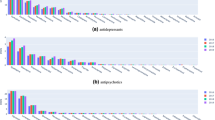Abstract
Objective To estimate outpatient utilization of psychotropic drugs before and after pharmaceutical reform in Latvia. Setting Data concerning prescribing and dispensing of psychotropic drugs were collected in six community pharmacies in the region of Latgale of Latvia. Method An exploratory analysis of prescription data provided by six community pharmacies from 2004 to 2007. Drugs included in the study were classified according to an Anatomical–Therapeutic–Chemical (ATC) drug classification system, and ATC data were used to calculate defined daily doses (DDD) per 1,000 inhabitants. The National SSK-10 classification was used for analysis of codes of disease diagnosis. Main outcome measures Identification of the most often prescribed psychotropic drug and prescribing physician, patient characterization by age and gender, and analysis of codes of diseases. Results Benzodiazepines and benzodiazepine-related drugs were mainly prescribed in outpatient practice. Diazepam was the most frequently prescribed benzodiazepine-12 DDD/1,000/day. The drugs were prescribed mainly by family physicians (in 66% of cases). Female residents bought more psychotropic drugs than males. In addition, residents of cities bought little more drugs than those living outside urban areas. Accordingly to the recorded disease codes, the codes for neurotic and behavioral disorders dominated. Conclusion The introduction of new norms neither increased nor decreased the number of psychotropic drug prescriptions filled. The most often prescribed psychotropic drugs over 4-year period were benzodiazepines and their derivates. Disease codes on the prescriptions fully justified a reason for psychotropic drug use.





Similar content being viewed by others
References
Convention on Psychotropic Substances. United Nations. Available from: http://www.incb.org/incb/convention_1971.html (1971). Accessed 25 May 2008.
State Statistical Board. Number of population in different regions of Latvia. Available from: http://www.pmlp.gov.lv/images/documents/ST_01_08.PDF. Accessed 25 May 2008.
Montanaro N, Magrini N, Vaccheri A, Battilan M. Drug utilization in general practice: prescribing habits of national formulary drugs by CPs of Emilia Romagna (Italy) in 1988 and 1989. Eur J Clin Pharmacol. 1992;42:401–8.
Shapiro S. The epidemiological evaluation of drugs. Acta Med Scand. 1982;Suppl 683:23–7.
Bergman U. Pharmacoepidemiology—from description to quality assessment. A Swedish perspective. Nor J Epidemiol. 2001;11:31–6.
Collaborating WHO. Centre for Drug Statistics Methodology. ATC/DDD version January, 2005. Available from: URL: http://www.whocc.no/atcddd/. Cited 25 May 2008.
Guidelines for ATC classification and DDD assignment 2003 6th ed. World Health Organization Collaborating Centre for Drug Statistics Methodology. Oslo: World Health Organization Collaborating Centre for Drug Statistics Methodology, 2002. ISBN 8280820256.
Wertheimer AI. The defined daily dose system (DDD) for drug utilization review. Hosp Pharm. 1986;21(3):233–4. 239–41, 258.
Sacristan JA, Soto J. Drug utilisation studies as tools in health economics. Pharmacoeconomics. 1994;5:299–312.
Ohayon MM, Lader MH. Use of psychotropic medication in the general population of France, Germany, Italy, and the United Kingdom. J Clin Psychiatry. 2002;63:817–25.
Alonso J, Angermeyer MC, Bernert S, Bruffaerts R, Brugha TS, Bryson H, et al. Psychotropic drug utilization in Europe: results from the European Study of the Epidemiology of Mental Disorders (ESEMeD) project. Acta Psychiatr Scand. 2004;109(s420):55–64. doi:10.1111/j.1600-0047.2004.00325.x.
van Hulten R, Leufkens HG, Bakker A. Usage patterns of benzodiazepines in a Dutch community a 10-year follow-up. Pharm World Sci. 1998;20:78–80. doi:10.1023/A:1008636707219.
van Hulten R, Isacson D, Bakker A, Leufkens HG. Comparing patterns of long-term benzodiazepine use between a Dutch and a Swedish community. Pharmacoepidemiol Drug Saf. 2003;12(1):49–53. doi:10.1002/pds.784.
van Hulten R, Teeuw KB, Bakker AB, Bakker A, Leufkens HG. Characteristics of current benzodiazepine users as indicators of differences in physical and mental health. Pharm World Sci. 2000;22:96–101. doi:10.1023/A:1008749220107.
Divac N, Jasović M, Djukić L, Vujnović M, Babić D, Bajcetić M, et al. Benzodiazepines utilization and self-medication as correlates of stress in the population of Serbia. Pharmacoepidemiol Drug Saf. 2004;13(5):315–22. doi:10.1002/pds.940.
Lechevallier-Michel N, Berr C, Fourrier-Réglat A. Incidence and characteristics of benzodiazepine use in an elderly cohort: the EVA study. Therapie. 2005;60(6):561–6. doi:10.2515/therapie:2005078.
Paakari P, Voipio T. The growing consumption of hypnotics and sedatives evens out. Natl Agency Medicines TABU. 2005;3:37–9.
Tómasson K, Tómasson H, Zoëga T, Sigfússon E, Helgason T. Epidemiology of psychotropic medication use: comparison of sales, prescriptions and survey data in Iceland. Nord J Psychiatry. 2007;61(6):471–8. doi:10.1080/08039480701773311.
Petitjean S, Ladewig D, Meier CR, Amrein R, Wiesbeck GA. Benzodiazepine prescribing to the Swiss adult population: results from a national survey of community pharmacies. Int Clin Psychopharmacol. 2007;22(5):292–8. doi:10.1097/YIC.0b013e328105e0f2.
Mirandola M, Andretta M, Corbari L, Sorio A, Nosè M, Barbui C. Prevalence, incidence and persistence of antipsychotic drug prescribing in the Italian general population: retrospective database analysis, 1999–2002. Pharmacoepidemiol Drug Saf. 2006;15(6):412–20. doi:10.1002/pds.1162.
Thiels C, Linden M, Grieger F, Leonard J. Gender differences in routine treatment of depressed outpatients with the selective serotonin reuptake inhibitor sertraline. Int Clin Psychopharmacol. 2005;20(1):1–7. doi:10.1097/00004850-200501000-00001.
Bachmann CS, Berg EA, Spigset O, Slørdal L. Benzodiazepine-like hypnotics—attitudes and prescription practice among general practioners. Tidsskr Nor Laegeforen. 2008;128(2):166–70.
Haynes RB, McKibbon A, Kanani R. Systematic review of randomised trials of interventions to assist patients to follow prescriptions for medications. Lancet. 1996;348:383–6. doi:10.1016/S0140-6736(96)01073-2.
Marinker M, Shaw J. Not to be taken as directed. BMJ. 2003;326:348–9. doi:10.1136/bmj.326.7385.348.
Acknowledgments
We thank all pharmacists of the selected community pharmacies.
Author information
Authors and Affiliations
Corresponding author
Rights and permissions
About this article
Cite this article
Vrublevska, K., Rukmane, J., Burmistrs, R. et al. Dispensing of psychotropic drugs to adults in community pharmacies in Latvia. Pharm World Sci 30, 934–939 (2008). https://doi.org/10.1007/s11096-008-9256-x
Received:
Accepted:
Published:
Issue Date:
DOI: https://doi.org/10.1007/s11096-008-9256-x



